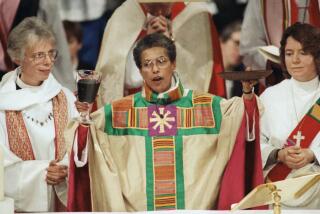Church of England to Ordain Women : Priesthood: Officials describe today’s ceremony for 33 women as a joyous occasion. But some alienated members are leaving, mostly for the Catholic Church.
- Share via
LONDON — When Christine Clarke drapes a clerical stole across both shoulders, becoming one of the Church of England’s first woman priests, she will fulfill a calling she has felt for 22 years.
“It’s been a long wait, but now there is a sense of everything coming together,” said Clarke, 48. “There is a feeling that for this I was born. Now we are walking right into the central structure of the church.”
After years of spiritual torment and theological wrangling, women are being admitted to the priesthood for the first time since King Henry VIII created the Church of England in the 16th Century.
The state church’s 1,200 woman deacons and their supporters are expected to pack Bristol Cathedral today for the ordination of 33 women by Bishop Barry Rogerson.
“It is going to be a very joyous occasion, a full house,” said the Rev. Paul Denyer, communications officer of the Bristol Diocese.
“It’s marvelous to have been able to put ourselves out of business,” said Caroline Davis, director of the Movement for the Ordination of Women, which was formed 15 years ago.
The church’s spiritual leader, Archbishop of Canterbury George Carey, has been a strong supporter of ordaining women, but the issue has tested the church’s traditional toleration of diversity.
*
“It is the humanity of Christ which is important, not his maleness,” Carey argued before the ordination of women was approved by the General Synod in November, 1992.
In making the change, the Church of England joined 12 of the 28 self-governing provinces of the worldwide Anglican Communion.
There are 1,381 women serving as Anglican priests, including 1,031 in the U.S. Episcopal Church, according to the Anglican Consultative Council. The Episcopal Church has ordained women since 1976, and in 1989 consecrated the first woman bishop.
Now Clarke and the others will be able to bless the bread and wine at Holy Communion, pronounce absolution and the forgiveness of sin, and give blessings--priestly duties previously forbidden to them. They will be allowed to wear their clerical stoles “priest-wise,” or across both shoulders, instead of “deacon-wise,” over just one.
Clarke, a deacon in Bristol, said she has encountered little opposition to her ordination, “but I cannot forget that others in the church are hurting over this.”
Jan Fortune-Wood, 32, who has three children, holds a doctorate in theology and has been a deacon for five years, has “felt called to the priesthood from childhood.” She said ordination will “remove that hollow center” in her ministry: the inability to celebrate Communion.
She also reported little opposition at her parish church, St. Andrew’s in Swindon, Bristol Diocese, where she is a counselor to single parents and the elderly.
“Two elderly ladies left early on, but everyone else is supportive,” she said.
*
Since the governing General Synod voted, 35 Anglican clergymen and several hundred lay people have quit the Church of England in protest, said church spokesman Steve Jenkins. Many joined the Roman Catholic Church, which does not permit women to be priests.
Last month, the Anglo-Catholic traditionalist group, Forward in Faith, released a statement signed by eight serving or retired bishops and 712 priests and deacons indicating they intended to forsake the church to become Roman Catholics.
“This is a matter of great sadness,” said Margaret Brown, co-founder of Women Against the Ordination of Women. “We are not just a few cranks. Votes in various synods have shown at least one-third of the church opposes women’s ordination.”
The Rev. Malcolm Widdecombe of Bristol, a prominent dissenter, believes the church “is moving into error.”
“This is against the tradition of the church and the teaching of Scripture,” he said. “Our Lord gave an honored position to women, but he chose men for the major tasks.”
Widdecombe believes ordaining women will be disastrous for church membership, which already is sparse. In a country of 55 million people, about 6.7 million belong to Christian churches, according to the United Kingdom Christian Handbook. The Church of England claimed 1.47 million, down 21% since 1975.
In an effort to accommodate dissenters, the General Synod put several limitations on woman priests. They may not become bishops, a parish may refuse to accept a woman as its priest, and bishops now in office cannot be compelled to ordain women or accept them as priests in their dioceses.
The synod also approved special severance pay arrangements, which became effective Feb. 22, for full-time priests who decide in the next 10 years to resign rather than accept women as colleagues.
In November, 1993, the General Synod--consisting of laity, clergy and bishops--prohibited discrimination against opponents of woman priests.
It also permitted dioceses, with bishops presiding, to make their own rules on acceptance of female priests. Parishioners may change to dioceses whose bishops have acceptable views on women’s ordination, and two “flying bishops” have been appointed to serve traditionalists throughout the country.
Despite all this, Brown said, in some cases “there is pressure on dissenters (among the clergy) to toe the line. Hints are given that they might not be promoted.”
Widdecombe says he will continue at his church, St. Philip and St. Jacob, “because my parishioners are very supportive and we have something good going.” He reported receiving inquiries from dissenters in other parishes about joining his flock of 200.
Canon John Simpson of Bristol cathedral said the first ordination service for women will be the same as for men, with “a few changes, such as using more inclusive language--changing ‘he’ to ‘she’--and some small alterations to the prayers on ministry.”
More to Read
Sign up for Essential California
The most important California stories and recommendations in your inbox every morning.
You may occasionally receive promotional content from the Los Angeles Times.












